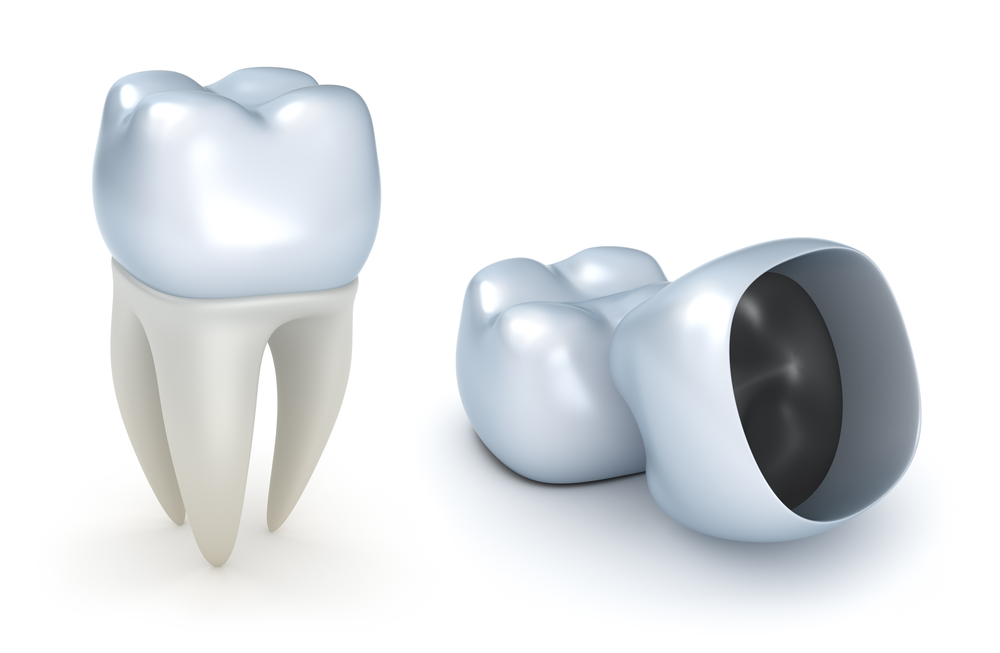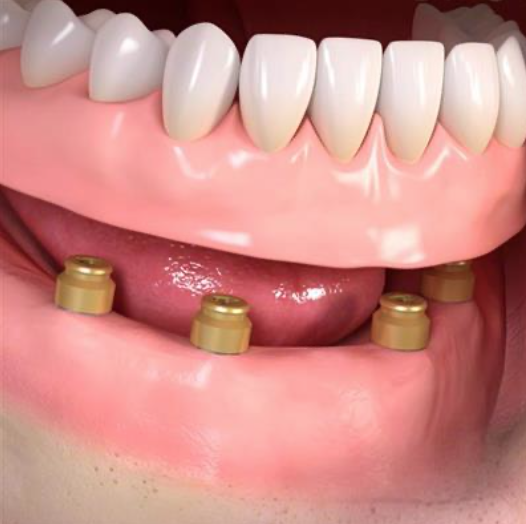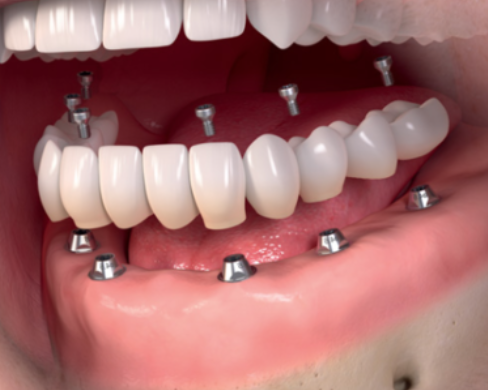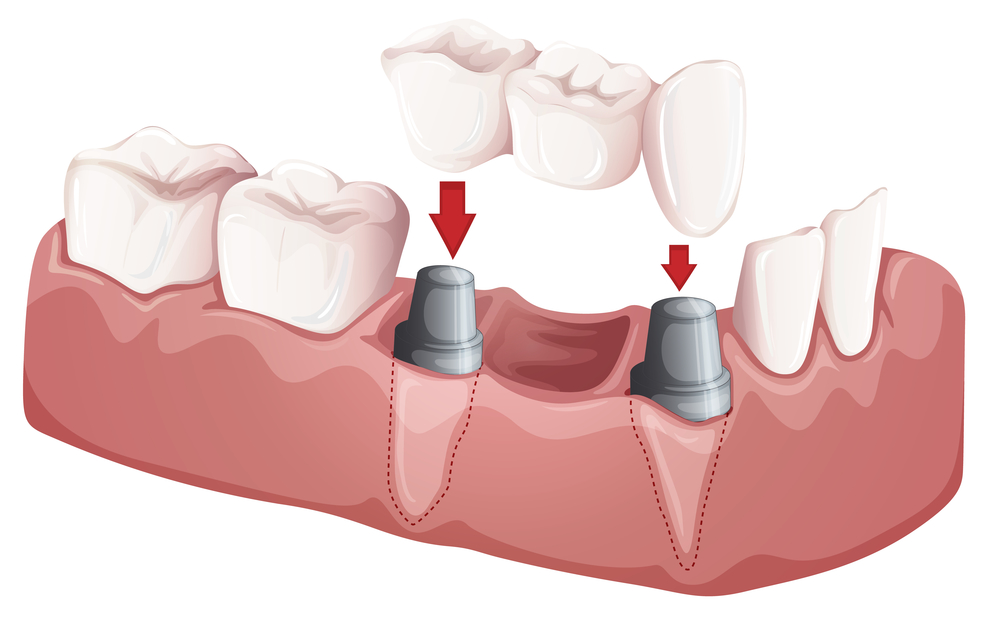You can trust your smile with us.
330 Winthrop Street, Westbury, NY 11590 New Patients: (516) 962-3518 Existing Patients: (516) 997-3636
Restorative Dentistry
Crowns
Crowns are full coverage restorations that are used to cover a tooth that is likely to break, or is too broken down to be restored with a filling. They are most commonly done after root canal treatment, or when a large filling wears out. The larger the hole made by a cavity that has to be treated, the more likely a crown will be needed. Even after a filling is put in a large cavity, a tooth is more likely to break.
It takes two appointments to restore a tooth with a crown. In the first any decay is removed from the tooth and it is shaped to accept the crown. Then a digital scan of the tooth is taken and emailed to the dental lab to fabricate your computer designed crown. Between the two visits the crown is made, usually milled by a robot-like milling machine. During this time a temporary crown is worn. In the second visit this temporary is removed. Then the permanent crown is adjusted as needed and then cemented in place. With digital scans, adjustments are less common, due to the computer’s accuracy, making the appointment quicker.

Drs. Smallberg and Satornino take the time to do a meticulous job preparing and scanning your tooth for a crown. Their attention to detail reduces the amount of appointments that you may need, due to a crown not fitting properly and having to be remade.
Implant Dentistry
It is not a well-known fact, but many people are walking around with very broken down teeth. This impacts their ability to smile and chew. These people are unhappy, but silent about their unfortunate condition. Many people are afraid that a removable denture is their only option. Some people are reminded about how their grandparents would put their teeth in a glass before bedtime or have trouble eating food, while their dentures would come loose at mealtimes. Missing teeth can even lead to a collapsed look in your face, making you look older.
We have treated many of these patients with newer options!
Implant-Retained Dentures
A more affordable option or for those who only have enough bone for fewer implants (usually 3-4) is the implant retained denture. A surgeon places implants in your bone and a removable denture is connected to implants with parts that look like snaps on a jacket. The dentures are removed at night, but during the day, stay in better and do not come loose easily, as they do without implants.
Once you lose a tooth, you start to lose the bone around the lost tooth. When you replace the lost tooth with an implant, you maintain the bone. Both of these options allow you to maintain your bone, eat without discomfort, and have a younger looking face.

Implant-Retained Full Arch Bridge
The surgeon places implants (usually 6-8) in your bone and we fit you for a full arch bridge that connects to the implants and stays in your mouth 24/7. You return to our office periodically to remove the bridge so that we can thoroughly clean underneath and change your screws (connecting your bridge to your implants), if necessary.

Speech and Esthetics
Whenever we are making a major change to your front teeth, we always take your cosmetics and speech abilities into account. We work closely with one of the country’s top labs, using digital photographs for cosmetics and digital videos for speech analysis. We may ask you to read a particular speech, while we video you, in order to prevent speech impediments with your new teeth. We may even have you wear temporary teeth for a period of time, in order to try out a new tooth position, to ensure comfort and ease of function, prior to the final placement of your new teeth.
Emergency Dentistry
Emergency and After Office Hours: Dental emergencies are never convenient or timely. At Smallberg & Satornino, DDS , P.L.L.C.we are committed to our patients’ dental health. We routinely see emergency patients as soon as possible. Many emergencies can be seen on the same day that you call. Please call our office as early in the day as possible so that we can work you into our schedule.
TMJ Treatment
Drs. Smallberg and Satornino both completed the University of Kentucky’s TMD and Orofacial Pain Mini Residency Program. Their knowledge and experience working with TMJ patients is unmatched and can provide contemporary therapies to alleviate discomfort and restore optimal function.
What’s causing my pain?
When your teeth don’t fit together properly and/or the two small joints in front of your ears – TMJ joints – don’t function smoothly, pain and pressure results. You may experience migraine headaches or unexplained facial, neck, shoulder, or jaw pain. Tooth wear, teeth grinding, tingling extremities, and chronic earaches are also on the long list of common problems caused by TMJ disorder.
Customized TMJ Therapy to Restore Comfortable Function
Improper bite alignment and temporomandibular joint (TMJ) problems can cause pain as well as deterioration of teeth and supporting structures. Dr. Smallberg and Dr. Satornino evaluate smiles for these problems as part of comprehensive treatment planning. As Dawson Academy graduates, they have knowledge of bite problems and TMJ-related issues and can provide contemporary therapies to alleviate discomfort and restore optimal function.
Common Causes of TMJ Disorder
There is no single cause for TMJ dysfunction. Any number of factors or combination of factors may be to blame including:
- Trauma to the head, neck, or face
- Trauma to the TMJ joint or arthritis
- Hormonal changes or imbalances
- Malocclusion (where the jaws do not line up correctly resulting in bite problems)
- Stress
Nightguards
For those experiencing TMJ-related symptoms, we often recommend custom nightguards. These personalized oral appliances are designed to be worn during sleep, providing a protective barrier between your upper and lower teeth. Nightguards help alleviate the strain on the TMJ, reducing jaw clenching and teeth grinding that often occur unconsciously during the night. By promoting a relaxed jaw position, nightguards contribute to better sleep quality and decreased TMJ-related discomfort.
We make nightguards that are custom made to the proper jaw position using a method that not many dentists use. Finding the exact spot where the patient’s muscles are the most relaxed.
Headaches/Head and Neck Pain: Finding the Source
TMJ disorders can manifest as headaches and head or neck pain. Our skilled professionals conduct thorough assessments to identify the root cause of your discomfort. Through a combination of targeted treatments and lifestyle recommendations, we aim to alleviate your symptoms and improve overall well-being.
Tooth Wear: Preserving Your Dental Health
TMJ issues can contribute to tooth wear, affecting the longevity and integrity of your teeth. At Smallberg & Satornino, we take a comprehensive approach to address both the TMJ disorder and any associated dental concerns. Through customized treatment plans, including nightguards and other therapeutic interventions, we work to preserve your dental health and enhance the longevity of your natural teeth.
Don’t let TMJ-related symptoms compromise your quality of life. Schedule a consultation at Smallberg & Satornino to explore personalized solutions that bring relief and promote optimal oral health. Our team is dedicated to restoring comfort and functionality to your jaw, helping you regain a pain-free and confident smile.
Bridges
This is an option for filling the space created by a missing tooth. It is formed to look like the missing tooth, and it takes its place in the mouth. The sides of a bridge use the two surrounding teeth for support, hence the name. A bridge replaces the missing tooth, both functionally and cosmetically. Bridge work is as much an art as it is an exact science. The materials used may be gold alloys, porcelain bonded to metal alloy, or all ceramic material. The choice of material depends on requirements for strength, wear, and/or esthetics.
It is important that a missing tooth be replaced as soon as possible for several reasons. If not treated the teeth surrounding the gap begin to shift inward, creating a destructive chain reaction. Teeth use their neighbors for support, and, with one missing, they start to “fall.” As this worsens the bite changes in response to the pressure. This can eventually result in problems with the entire jaw, e.g. TMJ. The surrounding teeth deteriorate and it is just a matter of time before they, too, are lost. Gum disease becomes a serious problem, with the difficulty of treatment increasing as the neglect continues.

Drs. Smallberg and Satornino take the time to do a meticulous job preparing and digitally scanning your teeth for a bridge. Their attention to detail reduces the amount of appointments that you may need, due to a bridge not fitting properly and having to be remade.
Dentures
There are different types of dentures, but they share their common function. They replace teeth that have too much decay to save, become loose or have been lost due to bone loss.
The entire mouth is examined and a determination is made as to which teeth will have to be removed, and which will remain. The unsalvageable teeth are then extracted. Dentures are fitted to go over or around whatever teeth remain in the mouth, depending on the type. There is an adjustment period after dentures are placed in the mouth, and it can take some getting used to. However, once accustomed to the dentures, all the normal functionality and appearance return and one just carries on as usual. Often implants can used to further stabilize the dentures.
Some patients have a history of multiple sets of dentures that are unhappy with. For those patients, Drs. Smallberg and Satornino work in conjunction with a local dental lab, with excellent attention to detail. Patients can be seen in the dental lab for some of their visits to work directly with a lab technician to achieve a customized denture. They will work with you to pick the shade and shape of denture teeth that you want. Please let the doctors know if you have been unhappy with your previous dentures, so that they can arrange for this service for you.
